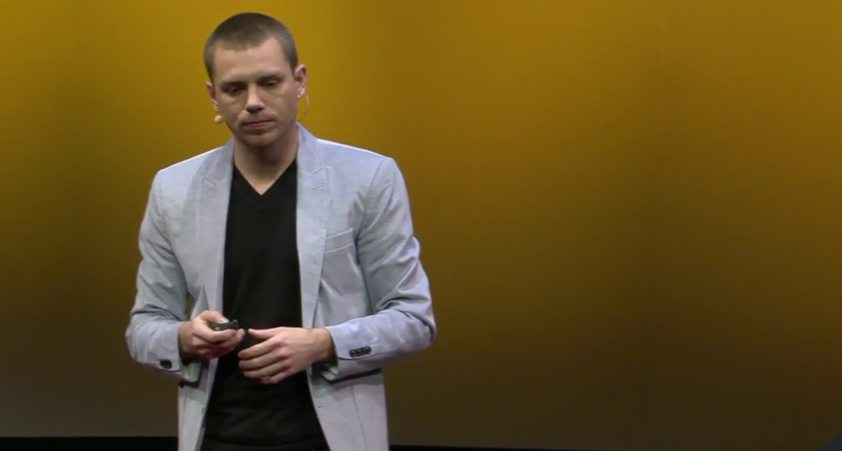So remember, I said 4D. So today for the first time, we're unveiling a new project, which is a collaboration with Stratasys, and it's called 4D printing.
还记得我刚才提到了四维,今天我们首次向大家展示一个新项目,这是和Stratasys公司一同合作的,它叫做4D(四维)打印。
The idea behind 4D printing is that you take multi-material 3D printing -- so you can deposit multiple materials -- and you add a new capability, which is transformation,
4D(四维)打印指的是我们利用多材料进行三维打印——就是我们可以使用多种材料——同时我们又新加一种能力,就是变形,
that right off the bed, the parts can transform from one shape to another shape directly on their own.
一但从车床上下来,这些不同的零部件就可以直接自发的变成其他的形状。
And this is like robotics without wires or motors.
就像是没有电线或者马达驱动的机器人。
So you completely print this part, and it can transform into something else.
所以我们把一个部分完整的打印出来,它就可以自己变成其它的物体形状。
We also worked with Autodesk on a software they're developing called Project Cyborg.
我们也和Autodesk(欧特克)合作了他们正在开发的Project Cyborg软件。
And this allows us to simulate this self-assembly behavior and try to optimize which parts are folding when.
这个项目让我们可以模拟自我组装这种行为以及优化哪些部件应该在何时折叠变形。
But most importantly, we can use this same software for the design of nanoscale self-assembly systems and human scale self-assembly systems.
但是,最重要的是,我们可以利用同样的软件设计纳米级的自我组装系统以及人类生活中的自我组装系统。
These are parts being printed with multi-material properties.
这些是用多材料属性打印出来的零件。

Here's the first demonstration. A single strand dipped in water that completely self-folds on its own into the letters M I T. I'm biased.
这是第一个演示,把一条链子浸在水里它可以完全自我折叠成字母M.I.T(美国麻省理工学院)。我确实偏心。
This is another part, single strand, dipped in a bigger tank that self-folds into a cube, a three-dimensional structure, on its own.
另外一个演示,把一条链子浸在一个大缸里,它会自我折叠变成一个三維结构的立方体,没有任何人力的影响。
So no human interaction. And we think this is the first time that a program and transformation has been embedded directly into the materials themselves.
我们认为这是首次把一个程序软件和变形一起直接的嵌入(应用)到材料中去。
And it also might just be the manufacturing technique that allows us to produce more adaptive infrastructure in the future.
或许这将是一种制造技术,能让我们在未来生产更多的可自我调节的基础设施设备。












